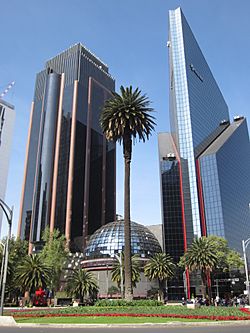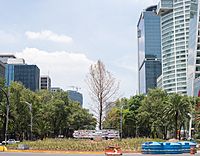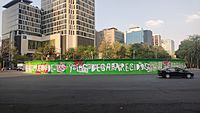Glorieta de la Palma facts for kids
Quick facts for kids Glorieta de la Palma |
|
|---|---|
| Roundabout | |
| Glorieta del Ahuehuete Glorieta de las y los Desaparecidos |
|
| Nickname(s): La Palma | |
 The roundabout in 2018 |
|
| Design: | Louis Bolland and Ferdinand von Rosenzweig |
| Opening date: | 1865 |
| Height: | 20 m (66 ft) (palm tree) |
| Location: | Cuauhtémoc, Mexico City |
| Address: | Paseo de la Reforma, Río Rhin Street and Niza Street |
The Glorieta de la Palma (which means "Palm Roundabout" in Spanish) is a famous traffic circle in Mexico City. It connects Paseo de la Reforma with Río Rhin Street and Niza Street. For over a century, it was known for a tall palm tree in its center. This roundabout is special because it's the only one on Reforma Avenue that has never had a big monument.
Near the roundabout, you can find the building of the Mexican Stock Exchange and the lively Zona Rosa area. The city's Metrobús system has a stop called La Palma here. Its symbol even shows the famous palm tree.
Sadly, the palm tree died in 2022 due to diseases. After a public vote, a new tree, an Taxodium mucronatum (also known as a Montezuma cypress or ahuehuete), was planted in June 2022. The city government then officially renamed the traffic circle the Glorieta del Ahuehuete (Ahuehuete Roundabout). At the same time, groups of activists placed a special memorial there. They renamed the spot the Glorieta de las y los Desaparecidos (Roundabout of the Disappeared). This was to remember the many people who have gone missing in Mexico. The first ahuehuete tree didn't adapt well and was later replaced with a similar one.
Contents
History of the Roundabout
The Glorieta de la Palma was part of the original design for Paseo de la Reforma. It was completed in 1865, making it the second roundabout finished on the avenue. The famous Angel of Independence monument was built in 1910. Some people thought this roundabout might get its own monument for Mexico's bicentennial in 2010.
Many palm trees were planted here over time. The earliest known photo showing the central palm is from 1920. Around 1950, all but the main central palm tree were removed.
The exact age of the palm tree was debated. Carlos Martínez Assad, a researcher, believed it was younger, about 70 to 80 years old. He suggested it might have been a gift from Haile Selassie, the Emperor of Ethiopia, to Mexican President Lázaro Cárdenas.
The Palm Tree's End
In 2022, the beloved palm tree died. It was infected by diseases and fungi that had affected other palm trees in the city. On April 24, the city held a farewell ceremony for the tree. That evening, it was cut down. Its remains were taken to a special plant center in Xochimilco. Artists planned to use the healthy wood to create sculptures. The palm tree was about 20 meters (65 feet) tall.
The Ahuehuete Tree Arrives
After the palm tree was removed, the city government asked people to vote on what tree should replace it. Options included a jacaranda or a Montezuma cypress. A palm tree was not an option because it could get the same diseases. Most people voted for a Montezuma cypress, also called an ahuehuete.
The city's mayor, Claudia Sheinbaum, announced the ahuehuete would be planted on June 5, 2022, which is World Environment Day. The new tree was 20 years old and came from Monterrey. It was about 10 meters (33 feet) tall and weighed 10 tons.
Challenges for the New Tree
Just two days after the ahuehuete was planted, a car crashed into the roundabout. It hit one of the wires holding the tree, causing it to lean. The tree looked dry for several weeks because of the accident and the change in its environment. By late July, it started to look better.
In September 2022, the city put up a fence around the roundabout. This was to protect the tree and help its recovery. Another car hit the fence the next month. In November 2022, an expert named Saúl Alcántara said the tree's chances of getting better were low. He thought the way it was replanted was the main problem.
On March 9, 2023, the city announced that the tree wasn't improving. They decided to replace it with another ahuehuete from the same nursery. Two days later, the first ahuehuete was removed and sent to Xochimilco for rehabilitation.
The replacement tree was planted on May 19, 2023. It was also 20 years old and about 12 meters (39 feet) tall. A few days later, a man climbed over the fence and poured fresh cement on the tree's roots. He also tried to remove its watering system. The man was arrested for damaging the tree and its environment. The mayor expressed her disappointment, suggesting that someone with a political motive might want to harm the tree.
The Roundabout of the Disappeared
On May 8, 2022, before the new tree was planted, groups looking for missing people took over the empty roundabout. They symbolically renamed it the Glorieta de las y los Desaparecidos (Roundabout of the Disappeared). They put up photos of missing people, similar to what feminists did at the nearby Glorieta de las mujeres que luchan. Their goal was to bring attention to the nearly 100,000 people reported missing in Mexico.
The mayor did not support their action, saying that one group's wishes couldn't override a public vote. Authorities removed the photos and banners shortly after. The activists said they weren't against the ahuehuete tree. They believed both ideas could exist together. They criticized the government for "disappearing the disappeared" by removing their memorial.
A few hours after the ahuehuete was planted, activists put the pictures of missing people back up. They called the new tree El Guardian de los desaparecidos ("The Guardian of the Disappeared"). They asked officials to officially rename the roundabout. Government representatives suggested that another monument on the avenue, the Estela de Luz, might be better for a memorial to the missing.
On July 24, 2022, human rights groups symbolically changed the names of two Mexico City Metrobús stations. They renamed Hamburgo to "Glorieta de las y los Desaparecidos." They also renamed Glorieta de Colón to "Glorieta de las Mujeres Que Luchan." These protest symbols were used on the station signs. Because of these many memorials, Paseo de la Reforma has been symbolically called the "Ruta de la Memoria" (Route of Memory).
On November 6, 2022, the photos were removed again. Christmas decorations were added to the security fences. The next week, activists repainted the area. They asked Andrés Manuel López Obrador, the president of Mexico, to keep his promise to meet with them about the disappearances.
In February 2023, the city government announced plans to place 20 volcanic rock memorials at the roundabout. These would be about 1.6 to 2 meters (5 to 6.5 feet) tall with poems carved on them. Groups searching for missing people criticized this plan. They said it was decided without their input. They compared it to the Memorial to Victims of Violence in Mexico nearby, which they called a "vile and offensive memorial." They also said they would change the new memorials if the project went ahead.
Images for kids
See also
 In Spanish: Glorieta del Ahuehuete para niños
In Spanish: Glorieta del Ahuehuete para niños






